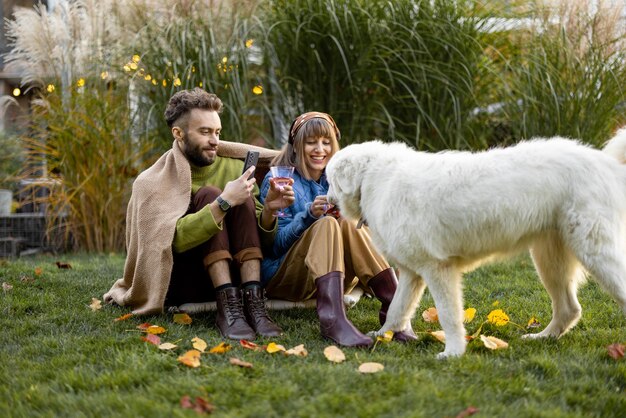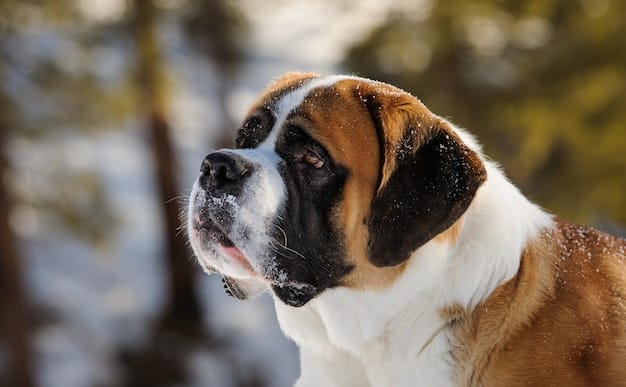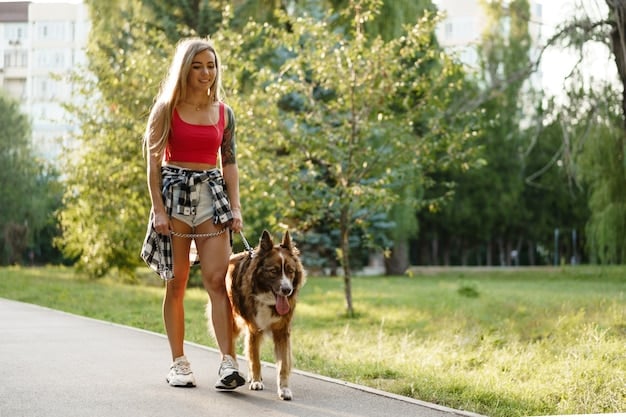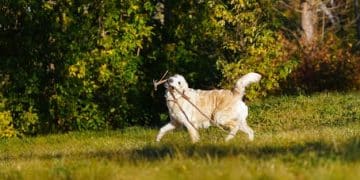Giant Dog Breeds: Breed Profiles and Considerations for US Families in 2025

Giant dog breeds, known for their impressive size and often gentle nature, require specific considerations for families in the US in 2025, encompassing health needs, space requirements, training, and overall lifestyle compatibility.
Considering adding a furry, oversized friend to your family in 2025? Exploring the world of giant dog breeds opens up exciting possibilities, but it’s crucial to understand the unique needs and considerations that come with these gentle giants for US families.
Understanding Giant Dog Breeds
Giant dog breeds are characterized by their significant size and weight, generally exceeding 100 pounds and standing over 28 inches tall. These breeds often possess a calm and affectionate temperament, making them excellent companions for families. However, their size also presents unique challenges that prospective owners must carefully consider.
Physical Characteristics
Giant breeds tower over smaller dogs. Their strength and build require careful management, especially during their rapid growth phases. Understanding their physical development is crucial for preventing joint and bone problems.
Temperament and Behavior
While generally gentle, giant breeds can be prone to specific behavioral issues if not properly trained and socialized. Early socialization is important to ensure their size doesn’t become a problem around strangers or smaller animals.
- Early socialization is key to a well-adjusted temperament.
- Consistent training is essential for managing their size and strength.
- Gentle handling reinforces positive behaviors and builds trust.
Giant dog breeds offer a rewarding experience for families prepared to meet their needs. Proper care, training, and a loving environment will make giant breeds delightful companions for years to come.
Popular Giant Dog Breeds: Breed Profiles
Several breeds immediately come to mind when visualizing giant dogs. Each has a distinctive history, temperament, and set of needs. The following profiles will help you understand some of the most popular giant breeds in the US.

Great Dane
Known for their imposing stature and friendly disposition, Great Danes are often referred to as “gentle giants.” They require early socialization and training to manage their size and energy levels.
Saint Bernard
Saint Bernards are known for their patient, nurturing nature and legendary work in rescuing travelers in the Swiss Alps. They thrive in colder climates and require ample space.
- Regular grooming is essential for Saint Bernards to manage shedding.
- They benefit from moderate exercise to maintain weight.
- Their gentle nature fits well with families and children.
Irish Wolfhound
Irish Wolfhounds are among the tallest dog breeds, standing as high as three feet at the shoulder. They possess a unique history of hunting wolves, and their loyal and gentle nature makes them excellent family pets today.
Exploring the unique characteristics enables prospective owners to ensure the appropriate giant breed finds a loving home. Knowledge about breed specific needs is of paramount importance.
Health Considerations for Giant Breeds
Giant dog breeds are more prone to specific health issues due to their size and rapid growth. Understanding these potential problems can help owners provide the best care and ensure a long and healthy life for their canine companions.
Hip and Elbow Dysplasia
These common skeletal conditions affect many giant breeds. Proper nutrition and controlled exercise during puppyhood can help minimize the risk.
Bloat (Gastric Dilatation-Volvulus)
Bloat is a life-threatening condition particularly prevalent in large, deep-chested dogs. Prevention includes feeding smaller, more frequent meals and avoiding vigorous exercise after eating.
- Regular veterinary check-ups can assist early detection of health problems.
- Understanding the symptoms of bloat is crucial for quick response.
- Maintaining a healthy diet helps prevent potential complications.
Cardiomyopathy
Cardiomyopathy, a disease of the heart muscle, is another concern. Regular screenings and a heart-healthy diet can help manage this condition.
Being informed about the diseases giant breeds are prone to, enables responsible ownership. Recognizing the crucial importance of preventative veterinarian care is important.
Training and Socialization Needs
Training is so important with large breeds. Early socialization is equally crucial because these large dogs must be gentle and safe around other people and pets. Establishing clear boundaries and consistent training is important.

Starting Early
Begin training and socialization as early as possible, ideally during puppyhood. Enroll in puppy classes to establish a solid foundation of obedience and good behavior.
Positive Reinforcement Techniques
Use positive reinforcement methods, such as treats and praise, to encourage desirable behaviors. Avoid punishment-based training, which can create fear and anxiety in giant breeds.
- Consistency is key to successful training.
- Socialize with a variety of people and environments.
- Address any behavioral problems early to prevent escalation.
Leash Training
Proper leash training is essential, as their size and strength can make them difficult to control on walks. Use a sturdy leash and collar, and teach them to walk politely beside you.
With these training practices and proactive socialization techniques, a responsible owner sets his or her big dog up for success. The result is a well-behaved, safe, and pleasant dog, as a consequence.
Space and Exercise Requirements
Giant dog breeds need plenty of space to move around and exercise. These animals are often restricted indoors due to their size, they will eventually become bored and potentially destructive, if not given adequate room to roam.
Ideal Living Environment
A spacious home with a large, fenced yard is ideal for giant breeds. Apartment living can be challenging unless you have plenty of time to dedicate to daily walks and outdoor activities.
Exercise Needs
While not all giant breeds are high-energy, they still need daily exercise to stay healthy and fit. Regular walks, playtime, and occasional hikes are essential.
- Provide mental stimulation to prevent boredom.
- Avoid over-exercising puppies to protect their developing joints.
- Adjust exercise routines to suit age and health conditions.
Creating a Comfortable Space
Ensure your giant breed has a comfortable place to rest and relax. Invest in a large, supportive bed and provide plenty of toys to keep them entertained.
Prioritizing their space and exercise is fundamental to their physical and mental wellbeing. Giving a giant dog space to stretch and roam helps improve their overall health and comfort.
Financial Implications of Owning a Giant Breed
The cost associated with owning a giant breed are higher than those of smaller dogs. The extra costs stem from increased food consumption, bigger vet bills and potentially larger homes.
Food Costs
Giant breeds need a lot of food to maintain their size and energy levels. Budget accordingly for high-quality dog food that meets their nutritional requirements.
Veterinary Expenses
Due to their predisposition to certain health issues, veterinary expenses can be higher for giant breeds. Regular check-ups, vaccinations, and potential treatments can add up.
- Pet insurance can help offset unexpected medical costs.
- Preventative habits alleviate potential for costly health issues.
- Look for veterinary clinics experienced with large breeds.
Grooming Costs
Some giant breeds, like Saint Bernards, require professional grooming to manage their shedding and coat health. Factor in these costs when budgeting for a giant breed.
Prospective owners should be prepared to budget for essential needs because this financial preparation can contribute to the giant breed’s welfare. The dog will be fed adequately, and cared for medically as needed.
Conclusion
Choosing a giant dog breed entails considering multiple aspects to ensure a harmonious match for US families in 2025. Giant breeds offer unique rewards for those ready to provide ample space, appropriate training, and financial support in an environment conducive to a happy fulfilling life.
| Key Aspect | Brief Description |
|---|---|
| 💪 Training | Consistent training is essential for managing their strength. |
| 🩺 Health | Regular vet checks help early detection of health issues. |
| 🏡 Space | Large yards are ideal for moving around. |
| 💰 Costs | Budgeting is important to address high food consumption. |
Frequently Asked Questions
▼
Popular choices include Great Danes, Saint Bernards, and Irish Wolfhounds. Each breed has unique traits, but most are known for their gentle nature and loyalty, making them great family additions.
▼
Giant breeds thrive in spacious environments with ample room to move. A large, fenced yard is ideal. While apartment living might be possible, it requires commitment to frequent outdoor activities.
▼
Common health issues include hip and elbow dysplasia, bloat, and cardiomyopathy. Regular veterinary check-ups, proper nutrition, and appropriate exercise can help minimize these risks.
▼
Training and socialization should begin as early as possible, ideally during puppyhood. Enroll in puppy classes focusing on obedience and positive behavior reinforcement to establish a strong foundation.
▼
Giant breeds often have higher costs due to increased food consumption, potential veterinary expenses, and professional grooming needs. Budgeting for these factors ensures responsible ownership and care.
Conclusion
The decision to welcome a giant dog breed into your family should be made after careful consideration of space, financial implications, health, and training needed to ensure responsible ownership.





